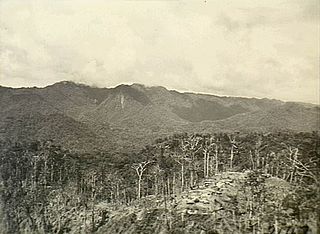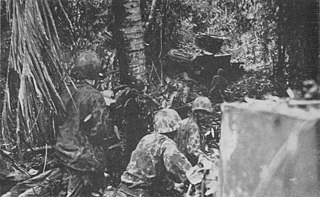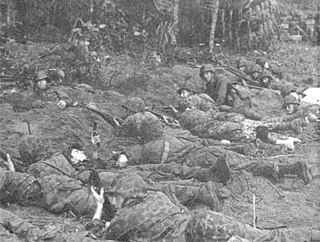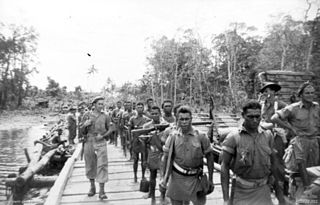
The Bougainville campaign was a series of land and naval battles of the Pacific campaign of World War II between Allied forces and the Empire of Japan, named after the island of Bougainville. It was part of Operation Cartwheel, the Allied grand strategy in the South Pacific.
Cape Torokina is a promontory at the north end of Empress Augusta Bay, along the central part of the western coast of Bougainville, in Papua New Guinea.

II Corps was an Australian Army corps, one of three that were raised by the Army during the Second World War. Formed in mid-1942 as part of defensive measures to protect the eastern coast of Australia from invasion, the corps was initially composed mainly of home defence troops drawn from the Militia. For a brief period in 1942, a US infantry division was also assigned to the corps prior to its dispatch to fight the Japanese in New Guinea.
Torokina is a coastal village on Bougainville Island, in the Autonomous Region of Bougainville, eastern Papua New Guinea. It is administered under Torokina Rural LLG.

The Landings at Cape Torokina, also known as Operation Cherryblossom, took place at the beginning of the Bougainville campaign in World War II. The amphibious landings were carried out by elements of the United States Marine Corps in November 1943 on Bougainville Island in the South Pacific, as part of Allied efforts to advance towards the main Japanese base around Rabaul under Operation Cartwheel. Coming in the wake of Allied successes at Guadalcanal and in the central Solomons, the landings were intended to secure a beachhead with the purpose of establishing several bases from which to project air and naval power closer towards Rabaul, in an effort to neutralize the large Japanese force that had been established there.

The Battle of Piva Forks, also known as the Battle of Numa–Numa Trail, was an engagement that took place during the Bougainville campaign in World War II. Occurring between 18 and 25 November 1943 on Bougainville Island in the South Pacific, the battle involved troops from the United States Marine Corps and the United States Army fighting against Imperial Japanese Army forces and took place amidst the context of the expansion of a beachhead that US forces had established around Torokina on the western side of the island.

The Battle of the Koromokina Lagoon was fought between the United States Marine Corps and Imperial Japanese Army forces on Bougainville Island. It took place on 7–8 November 1943 during the Bougainville campaign of the Pacific War.

The 19th Marine Regiment was a composite engineer regiment of the United States Marine Corps subordinate to the 3rd Marine Division. It existed from September 1942 until September 1944. In December 1943 there was a large change of command in the regiment. Marine engineer regiments were eventually disbanded in favor of independent engineering battalions within the parent Marine divisions.

The 31st/51st Battalion was an infantry battalion of the Australian Army, which served during World War II. Raised for service as part of the Militia in 1943 through the amalgamation of two previously existing battalions, the 31st/51st Battalion undertook garrison duties in Dutch New Guinea in 1943–44 before taking part in the Bougainville Campaign in 1944–45. Following the end of the war, the battalion served in the Pacific overseeing the transfer of Japanese prisoners of war and re-establishing law and order until mid-1946 when it returned to Australia and was disbanded.

The Battle of Porton Plantation took place near the village of Soraken on Bougainville Island, in the Solomon Islands archipelago during World War II. Involving forces from Australia, New Zealand and Japan, the battle was part of the wider Bougainville campaign, which had begun in late 1943 and lasted until the end of the war in August 1945. The battle formed part of Australian efforts to liberate the northern part of Bougainville.

The Battle of Pearl Ridge was an engagement of the Second World War fought between Australian and Japanese forces on Bougainville Island. Part of the wider Bougainville Campaign, the battle took place in the central sector of the island, shortly after the Australians had taken over responsibility from the Americans. Believing that the ridge was held by less than a company of Japanese, on 30 December the Australian 25th Infantry Battalion launched a four-pronged attacked the ridge. The defending force, however, had been greatly reinforced by elements of the 38th Independent Mixed Brigade and was closer to a battalion in strength. After being held up on the right of their advance, the Australians dug in overnight and repulsed a strong Japanese counterattack before resuming the attack on 31 December. By late in the afternoon, the Japanese had been swept off the ridge. The Australians later established an observation post on the ridge, which had commanding views of the whole island, and throughout the remainder of the campaign used it to control artillery fire as they advanced towards Japanese enclaves in the north and south of the island.

The Battle of the Coconut Grove was a battle between United States Marine Corps and Imperial Japanese Army forces on Bougainville Island during the Pacific War. The battle took place on 13–14 November 1943 during the Bougainville campaign, coming in the wake of a successful landing around Cape Torokina at the start of November, as part of the advance towards Rabaul as part of Operation Cartwheel.

The Raid onKoiari was a battle that occurred between 28 and 29 November 1943 in the Pacific theater of World War II between American and Japanese forces. Part of the Bougainville campaign, the raid involved a landing by a battalion-sized force of United States Marines to harass Imperial Japanese Army troops on Bougainville Island. The raid was a failure for the Americans as they were attacked by a larger-than-expected Japanese force and as a result the Marines were withdrawn from the beachhead without having achieved any of their objectives.
The Piva Trail is a trail on Bougainville, part of the Solomons chain, that runs alongside the Piva River, connecting to the East West Trail and the Numa Numa Trail.

The Battle of Ratsua occurred during the Second World War and involved Australian and Japanese forces. Part of the wider Bougainville Campaign of the Pacific theatre, the battle took place in the northern sector of Bougainville between June and August 1945. The main forces that took part in the fighting were the Australian 23rd Brigade and the Japanese 87th Naval Garrison Force.

The Battle of Hellzapoppin Ridge and Hill 600A consisted of a series of engagements fought in mid-December 1943 on Bougainville between forces of the United States Marine Corps and the Imperial Japanese Army. Although minor in terms of casualties and in comparison to other battles in the Bougainville campaign, the battle was the last significant action undertaken by the 3rd Marine Division on the island before they were replaced by United States Army soldiers from XIV Corps. It resulted in the capture of the two positions by the Marines with the support of artillery and aircraft, and the withdrawal of the Japanese forces as the American perimeter, which had been established around Torokina in November, was expanded towards the Torokina River.

The Bougainville counterattack, also known as the Second Battle of Torokina, was an unsuccessful Japanese offensive against the Allied base at Cape Torokina on Bougainville Island during the Pacific Theater of World War II. The Japanese attack began on 8 March 1944 after months of preparation and was repulsed by United States Army forces in fighting which lasted until 25 March. The attack was hampered by inaccurate intelligence and poor planning and was pushed back by the well-prepared Allied defenders, who greatly outnumbered the Japanese force. The Japanese suffered severe casualties, while Allied losses were light.

The Battle for Piva Trail was a battle between United States Marine Corps and Imperial Japanese Army forces on Bougainville Island. The battle took place on 8–9 November 1943 during the Bougainville campaign of the Pacific War in the days following the US landings at Cape Torokina earlier in the month.
Numa Numa is a mission on Bougainville Island, Papua New Guinea. It has a nearby harbour known as the Numa Numa Harbour on the eastern coast of Bougainville Island on the Pacific Ocean and is located near Wakunai, Teperoi and Casuarina Island. Nearby is the Wakunai Airport.















